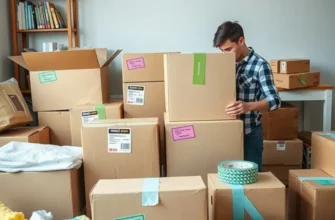Moving can feel like a chaotic episode of a reality show, with boxes stacked to the ceiling and half-empty coffee cups scattered like trophies of hard work. Amid all the excitement and stress, one question looms: “What if something gets damaged?” For young adults, first-time renters, and budding professionals, understanding moving insurance adds a layer of comfort to this transition. It’s not just about getting your stuff from point A to point B; it’s about ensuring that if life happens—like a dropped box or an unfortunate furniture mishap—you’re covered. So grab that coffee (for energy) and let’s dive into the world of moving insurance. Spoiler alert: it’s not as boring as it sounds, and it might just save you a lot of hassle and heartbreak later on.
What is Moving Insurance? The Essentials You Need to Know

Moving to a new home is an exciting adventure, but if things go awry during the move, that excitement can quickly turn into a nightmare. Here’s where moving insurance comes into play. Understanding the nuances of moving insurance is crucial for young renters to safeguard their belongings and ensure peace of mind.
At its core, moving insurance is a type of coverage designed to protect your possessions during a move. This insurance covers potential damage or loss of your items as they travel from your old place to your new one. There are different types of moving insurance, each with its unique scope and conditions.
Types of Coverage
One common type of moving insurance is released value protection, which is often bundled with moving services at no added cost. However, this coverage is minimal, typically offering around $0.60 per pound per item. This means if a heavy yet inexpensive item is damaged, the compensation might not cover the actual value.
Another option is full value protection. This type involves a higher upfront cost but covers the full repair or replacement value of any lost or damaged items. Some movers offer different levels of this coverage, so reviewing these options thoroughly is essential.
For renters using personal vehicles or rental trucks, opting for a separate personal property insurance can be a good idea. This extends your existing renters insurance to the move, sometimes at no extra cost. Always check with your current policy provider to see if your renters insurance includes this option.
Key Terms to Understand
-
Deductible: This is the amount you pay out of pocket before the insurance coverage kicks in. Understanding these terms helps you calculate potential expenses more accurately.
-
Liability Coverage: Not to be confused with personal property coverage, this protects against scenarios where a mover might cause injury or property damage during the move.
-
Exclusions: These are items or situations not covered by your policy. This might include valuable items like jewelry or high-value electronics.
What to Look for in a Policy
When examining policies, clarity is crucial. Ensure you delve into every detail of what’s covered under the policy and aware of any exclusions or special conditions. Reading reviews of the moving company you are choosing can offer insights into their reliability. Also, verify if the moving company has a history of claims to ensure their integrity.
Another aspect is examining how claims are processed. A company with a swift and customer-friendly claims process can save you a lot of hassle if things go wrong.
Additionally, factor in the local insights about renting and moving, such as evaluating the neighborhoods in Gainesville, FL, for renters here. Gaining knowledge about local renting dynamics can enhance your moving experience.
Navigating the world of moving insurance may seem daunting at first, but knowing these fundamentals empowers you to make informed decisions. By understanding the types of coverage, key terms, and crucial policy features, you safeguard your possessions while easing the transition into your new abode.
Making the Smart Choice: Tips for Selecting the Right Insurance

When it comes to securing your belongings during a move, choosing the right moving insurance is crucial. Begin by evaluating what items need coverage and the level of protection you desire. Not all insurance policies are created equal; some offer comprehensive protection while others cover only basic risks.
Start by asking the right questions. What is the value of the items being moved? Does the moving company offer insurance, or do you need to seek third-party coverage? It’s also important to understand the types of coverage available. Full value protection allows for repair, replacement, or a cash settlement if an item is lost or damaged. On the other hand, released value protection offers minimal coverage, usually calculated per pound. Evaluate which option suits your needs and budget.
Next, dive deeper into policy specifics, and always read the fine print. Understand what is covered and note any exclusions. Some policies may not cover items of extraordinary value such as jewelry, antiques, or electronics unless specified.
Contrast different policies by obtaining multiple quotes. Most movers provide an estimate based on the weight and distance of your move. When comparing, don’t solely focus on price. Look for policies that offer the best balance of cost and coverage. Ensure your policy protects against common perils while validating any deductibles or out-of-pocket responsibilities you might incur.
Furthermore, confirm the claims process and any documentation needed. Knowing how to file a claim, the timeline for processing, and support from customer service can save you stress later on. Discuss potential scenarios and confirm the company’s responsiveness and assistance in case of disputes.
It’s also worth noting that your existing rental insurance policy might extend some coverage for moving. Contact your provider to check if this applies, minimizing the additional insurance you need to purchase.
For additional insights related to protecting your home and belongings, consider exploring rental property safety responsibilities to ensure that your current living space is also safeguarded.
By actively comparing options and asking the right questions, young renters can make informed decisions that protect their belongings and provide peace of mind throughout their moving experience.
Final words
Moving insurance is like that trusty umbrella you keep in your car; it’s often forgotten until you really need it. Whether you’re a couple starting a new chapter, a young professional making the big leap, or a family ready to settle into a new home, investing in moving insurance can help safeguard your belongings against the unexpected. By understanding what insurance options are available and making informed choices, you can focus less on what-ifs and more on settling into your new space. So the next time you find yourself surrounded by boxes, remember: a little moving insurance can go a long way. Happy moving!









